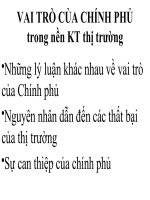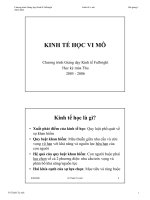Bài giảng kinh tế vi mô chap6 premium
Bạn đang xem bản rút gọn của tài liệu. Xem và tải ngay bản đầy đủ của tài liệu tại đây (400.25 KB, 33 trang )
6
Supply, Demand, and
Government Policies
PRINCIPLES OF
FOURTH EDITION
N. G R E G O R Y M A N K I W
PowerPoint® Slides
by Ron Cronovich
© 2007 Thomson South-Western, all rights reserved
In this chapter, look for the answers to
these questions:
What are price ceilings and price floors?
What are some examples of each?
How do price ceilings and price floors affect
market outcomes?
How do taxes affect market outcomes?
How does the outcome depend on whether
the tax is imposed on buyers or sellers?
What is the incidence of a tax?
What determines the incidence?
CHAPTER 6
SUPPLY, DEMAND, AND GOVERNMENT POLICIES
2
Government Policies That Alter the
Private Market Outcome
Price controls
•
•
Price ceiling: a legal maximum on the price
of a good or service. Example: rent control.
Price floor: a legal minimum on the price of
a good or service. Example: minimum wage.
Taxes
•
The govt can make buyers or sellers pay a
specific amount on each unit bought/sold.
We
We will
will use
use the
the supply/demand
supply/demand model
model to
to see
see
how
how each
each policy
policy affects
affects the
the market
market outcome
outcome
(the
(the price
price buyers
buyers pay,
pay, the
the price
price sellers
sellers receive,
receive,
and
and eq’m
eq’m quantity).
quantity).
CHAPTER 6 SUPPLY, DEMAND, AND GOVERNMENT POLICIES
3
EXAMPLE 1: The Market for Apartments
P
Rental
price of
apts
S
$800
Eq’m
Eq’m w/o
w/o
price
price
controls
controls
D
300
Q
Quantity of
apartments
CHAPTER 6
SUPPLY, DEMAND, AND GOVERNMENT POLICIES
4
How Price Ceilings Affect Market Outcomes
A price ceiling
above the
eq’m price is
not binding –
it has no effect
on the market
outcome.
P
S
Price
ceiling
$1000
$800
D
300
CHAPTER 6
SUPPLY, DEMAND, AND GOVERNMENT POLICIES
Q
5
How Price Ceilings Affect Market Outcomes
The eq’m price
($800) is above
the ceiling and
therefore illegal.
The ceiling
is a binding
constraint
on the price,
and causes
a shortage.
CHAPTER 6
P
S
$800
Price
ceiling
$500
shortage
250
D
400
SUPPLY, DEMAND, AND GOVERNMENT POLICIES
Q
6
How Price Ceilings Affect Market Outcomes
In the long run,
supply and
demand
are more
price-elastic.
So, the
shortage
is larger.
P
S
$800
Price
ceiling
$500
shortage
150
CHAPTER 6
450
SUPPLY, DEMAND, AND GOVERNMENT POLICIES
D
Q
7
Shortages and Rationing
With a shortage, sellers must ration the goods
among buyers.
Some rationing mechanisms: (1) long lines
(2) discrimination according to sellers’ biases
These mechanisms are often unfair, and inefficient:
the goods don’t necessarily go to the buyers who
value them most highly.
In contrast, when prices are not controlled,
the rationing mechanism is efficient (the goods
go to the buyers that value them most highly)
and impersonal (and thus fair).
CHAPTER 6
SUPPLY, DEMAND, AND GOVERNMENT POLICIES
8
EXAMPLE 2: The Market for Unskilled Labor
Wage
paid to
unskilled
workers
W
S
$4
Eq’m
Eq’m w/o
w/o
price
price
controls
controls
D
500
L
Quantity of
unskilled workers
CHAPTER 6
SUPPLY, DEMAND, AND GOVERNMENT POLICIES
9
How Price Floors Affect Market Outcomes
A price floor
below the
eq’m price is
not binding –
it has no effect
on the market
outcome.
W
S
$4
Price
floor
$3
D
500
CHAPTER 6
SUPPLY, DEMAND, AND GOVERNMENT POLICIES
L
10
How Price Floors Affect Market Outcomes
The eq’m wage ($4)
is below the floor
and therefore
illegal.
The floor
is a binding
constraint
on the wage,
and causes
a surplus
(i.e.,
unemployment).
CHAPTER 6
W
labor
surplus S
Price
floor
$5
$4
D
400
550
SUPPLY, DEMAND, AND GOVERNMENT POLICIES
L
11
The Minimum Wage
Min wage laws
do not affect
highly skilled
workers.
They do affect
teen workers.
Studies:
A 10% increase
in the min wage
raises teen
unemployment
by 1-3%.
CHAPTER 6
W
unemployment S
Min.
wage
$5
$4
D
400
550
SUPPLY, DEMAND, AND GOVERNMENT POLICIES
L
12
ACTIVE LEARNING
Price floors
& ceilings
P
1:
The market for
hotel rooms
S
Determine
effects of:
A. $90 price
ceiling
D
B. $90 price
floor
C. $120 price
floor
0
Q
13
ACTIVE LEARNING
A. $90 price ceiling
P
1:
The market for
hotel rooms
S
The price
falls to $90.
Buyers
demand
120 rooms,
sellers supply
90, leaving a
shortage.
Price ceiling
D
shortage = 30
0
Q
14
ACTIVE LEARNING
B. $90 price floor
P
1:
The market for
hotel rooms
Eq’m price is
above the floor,
so floor is not
binding.
P = $100,
Q = 100 rooms.
Price floor
0
S
D
Q
15
ACTIVE LEARNING
C. $120 price floor
P
The price
rises to $120.
1:
The market for
hotel rooms
surplus = 60
S
Price floor
Buyers
demand
60 rooms,
sellers supply
120, causing
a surplus.
D
0
Q
16
Evaluating Price Controls
Recall one of the Ten Principles:
Markets are usually a good way
to organize economic activity.
Prices are the signals that guide the allocation of
society’s resources. This allocation is altered
when policymakers restrict prices.
Price controls are often intended to help the poor,
but they often hurt more than help them:
• The min. wage can cause job losses.
• Rent control can reduce the quantity and quality
of affordable housing.
CHAPTER 6
SUPPLY, DEMAND, AND GOVERNMENT POLICIES
17
Taxes
The govt levies taxes on many goods & services
to raise revenue to pay for national defense,
public schools, etc.
The govt can make buyers or sellers pay the tax.
The tax can be a percentage of the good’s price,
or a specific amount for each unit sold.
• For simplicity, we analyze per-unit taxes only.
CHAPTER 6
SUPPLY, DEMAND, AND GOVERNMENT POLICIES
18
EXAMPLE 3: The Market for Pizza
Eq’m
Eq’m
w/o
w/o tax
tax
P
S1
$10.00
D1
500
CHAPTER 6
SUPPLY, DEMAND, AND GOVERNMENT POLICIES
Q
19
A Tax on Buyers
A
A tax
tax on
on
buyers
buyers shifts
shifts
the
the D
D curve
curve
down
down by
by the
the
amount
amount of
of
the
the tax.
tax.
The
The price
price
buyers
buyers pay
pay
rises,
rises, the
the
price
price sellers
sellers
receive
receive falls,
falls,
eq’m
eq’m Q
Q falls.
falls.
CHAPTER 6
P
PB = $11.00
Effects of a $1.50 per
unit tax on buyers
S1
Tax
$10.00
PS = $9.50
D1
D2
430 500
SUPPLY, DEMAND, AND GOVERNMENT POLICIES
Q
20
The Incidence of a Tax:
how the burden of a tax is shared among
market participants
P
Because
Because
of
of the
the tax,
tax,
PB = $11.00
buyers
buyers pay
pay
$10.00
$1.00
more,
$1.00 more,
PS = $9.50
sellers
sellers get
get
$0.50
$0.50 less.
less.
S1
Tax
D1
D2
430 500
CHAPTER 6
SUPPLY, DEMAND, AND GOVERNMENT POLICIES
Q
21
A Tax on Sellers
A
A tax
tax on
on
sellers
sellers shifts
shifts
the
the S
S curve
curve
up
up by
by the
the
amount
amount of
of
the
the tax.
tax.
The
The price
price
buyers
buyers pay
pay
rises,
rises, the
the
price
price sellers
sellers
receive
receive falls,
falls,
eq’m
eq’m Q
Q falls.
falls.
CHAPTER 6
P
PB = $11.00
Effects of a $1.50 per
unit tax on sellers
S2
Tax
S1
$10.00
PS = $9.50
D1
430 500
SUPPLY, DEMAND, AND GOVERNMENT POLICIES
Q
22
The Outcome Is the Same in Both Cases!
The effects on P and Q, and the tax incidence are the
same whether the tax is imposed on buyers or sellers!
P
What matters
is this:
PB = $11.00
A tax drives
$10.00
a wedge
PS = $9.50
between the
price buyers
pay and the
price sellers
receive.
CHAPTER 6
Tax
S1
D1
430 500
SUPPLY, DEMAND, AND GOVERNMENT POLICIES
Q
23
ACTIVE LEARNING
Effects of a tax
P
Suppose govt
imposes a tax
on buyers of
$30 per room.
Find new
Q, PB, PS,
and incidence
of tax.
2:
The market for
hotel rooms
S
D
0
Q
24
ACTIVE LEARNING
Answers
P
2:
The market for
hotel rooms
S
Q = 80
PB = $110
PS = $80
PB =
Tax
D
PS =
Incidence
buyers: $10
sellers: $20
0
Q
25









